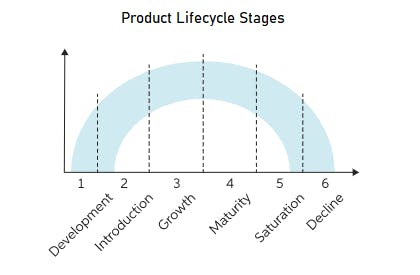Launching a new product can be an overwhelming process, but having the right product launch-to-market plan can certainly make you breathe easier. Once you have a marketing plan for a new product launch, you’ll have all kinds of the necessary information at hand. From defining your target audience and how to find them, determining the optimal price for your product, or knowing which selling point to highlight in your messaging and advertisements, a new product launch marketing plan can help you to tackle all kinds of obstacles without panic.
Product Launch Marketing
You have a product that is almost ready to launch to market and announce to the world, so what do you do next? Before you take another step, you need to create a solid product launch marketing plan that will outline the messaging and marketing strategy. The stronger your strategy, the closer you get to your bottom line, which is getting customers to adopt your new product.
So how do you market a product launch? It’s a planned and coordinated effort! Let’s dig deeper together on how you can make sure everyone from members of your company, your partners, and of course, your target customers know about your brand new product!
Product Lifecycle Stages

One key piece of information you’ll need to be a bit more versed in to be able to build a marketing strategy to promote your new product is the product lifecycle. A product lifecycle is the amount of time from when a product is first introduced to the consumer market up till it either dies out or stops being sold. It is broken down into different stages:
- Development
- Introduction
- Growth
- Maturity
- Saturation
- Decline
Other experts break it down to the stages of ideation, innovation, market analysis, testing, launch, and post-launch. In either case, the process of product launch marketing is an ongoing process, made up of various stages. Understanding where you are in the lifecycle of a product helps you to make important decisions, for example, when to increase advertising, when to adjust the price of your product, when it’s time to explore new markets, redesign your packaging or change your messaging.
If you found this article, then you’ve probably in the middle of the product development process. This is basically your research phase when you are trying to understand the viability of your product, determine if it’s ready to go to market, and decide how you want to approach the launch.
Next, you’ll be ready to jump into the introduction phase, that is, the stage when your product is first launched in the marketplace.
This is when you are trying to understand your target market better, understand the competitive landscape and focus on raising product awareness!
At this stage, marketing costs will be high, but it’s a necessary evil if you want to be able to reach your potential customers. Now is your time to test different distribution channels and messaging to see what works best.
This is also the point where you work to acquire property rights protection.
It may take some time, and money, before you start to finally gain traction in this phase, but don’t lose hope. The efforts made now will likely set the stage for the future success of your product.
In the growth stage, your product has already gained some acceptance from customers, and your focus will shift more to increasing your market share. In this stage, your demand and revenue should be growing steadily. This is the time for you to fine-tune your messaging and strengthen your brand presence.
When your sales start to level off, you’ve probably reached the maturity and saturation stage. Don’t panic, you are probably still growing, just not at the same rapid rates as before. This is the point when you may consider implementing a different marketing strategy to promote your new product. This includes making adjustments to the price of your product, offering free additions, or incorporating add-ons to keep your product competitive.
If you’ve reached the decline stage, then it’s the end of the line. This is the point of the product lifecycle associated with a decrease in revenue, high competition, and changes in the needs of your customers. At this point, you’ll either need to completely discontinue your product, find new uses for your product, sell the manufacturing rights to another business or try to find new markets that you haven’t tapped into yet.
This is the difficult point in the lifecycle where you need to weigh out the costs and benefits of each option and move forward from there.
Understanding How Does Launch Plan Fits in the Bigger Picture
Understanding how the marketing strategy for a new product launch fits in the bigger picture will help you to determine how you want to build awareness in the introduction stage, as well as recognize when it’s time to transition from one stage to the other.
This is the kind of foresight you’ll need to determine what your goals are in each stage and how long you intend to stay in each stage.
Go-To-Market Strategy or What Will Happen Without It
Part of your product launch marketing plan is your Go-To-Market (GtM) strategy framework. Without one, you’ll never be able to understand if you’re targeting the wrong audience, if you’ve messed up the timing of entering a market, or if your target market is too saturated for you to get noticed. With a go-to-market strategy, you can avoid wasting valuable time and resources, as well as a wide range of obstacles that may pop up during product launch marketing.
So what is a GtM strategy? Well, a well-thought-out GtM strategy allows you to map out your target audience, marketing plan, and even a sales strategy. It’s a roadmap that helps you measure how viable your product is as a solution to a market problem, and if planned well, it can help you predict the performance of your product based on data from market research, other market examples, and competitors’ data.
First, you start off with a market problem, then you position your product as the solution to that problem and go from there.
Not having a well-developed marketing plan for a new product launch or a fully hashed-out GtM strategy could be the difference between a successful product launch or a complete flop. While it isn’t a guarantee against failure, a go-to-market plan can definitely help you prevent mistakes and oversights that can lead to disastrous product launches.
Key focal points of a well-rounded GtM strategy include:
- Recognize your buyer persona(s).
- Filling out the buyer persona’s value matrix.
- Defining your content and lead generation strategy.
- Adjusting and iterating along the way
- Retaining and satisfying your customers.
The main marketing steps for a new product launch start with understanding your product-market fit. Here you need to be able to answer the question, “What problem(s) does my product solve?”
Then you need to really understand your target audience. Who is dealing with this problem? How much will they be willing to pay for your solution? What are their pain points, what infuriates and frustrates them, and how can you help?
Next, you need to understand your market demand and the competition. Are there others in the market offering their own solutions to this problem? Maybe there are too many and the market is already oversaturated. Or maybe the opposite is true, and there isn’t really demand.
Finally, really try to figure out your plan for distribution. What is the best way for you to reach your target audience? Where are they found? What mediums and channels will you use? What will be your main means of communicating (website, app, third-party distributor, etc.)?
Each of these focal points can then branch out even deeper, coming together to form a killer product launch marketing plan.
Steps for an Effective Product Launch Strategy
From identifying your buyer personas and crafting a value matrix in order to optimize your messaging to working on the nitty-gritty details of your ads based on testing and creating the right content to get inbound leads, there are many marketing steps for a new product launch to consider.
Let’s dive into the details of a product launch marketing plan.
Prelaunch Documentation
One of the first product launch strategy steps is creating and having in-depth product launch documentation. Here you’ll need to write out all of the relevant information you can imagine regarding the product. This documentation is essential for internal use, but elements can be used for public material down the line.
Common topics covered in prelaunch product documentation include descriptions of your goals, features, business and customer value, research and validation, functionality and usage, and more.
For example, this may be a new iteration of an existing product. In this case, you might choose to compare the new and old functionalities in your documentation.
Other factors to consider including in your documentation are links to other sources or your planned rollout time.
Your documentation is your go-to source for all basic information about your product, including guides, features, release notes, answers to FAQs, etc. It is where your team can get the answers they need to important questions about your product, making it an essential tool in your product launch marketing strategy.
Pre-Sales Strategy
Here we’ll take a closer look at some product launch marketing activities, with a particular focus on your pre-sales strategy.
Implement Email Marketing Strategy
One of the first marketing steps for a new product launch is implementing a calculated email marketing strategy. It’s a very popular way to create a buzz around your product, by grabbing attention, building anticipation, and even driving early orders!
Once you’ve built your email list consisting of prospective partners and customers, you can start pushing engaging email messages. From Teaser emails, where you pique your followers’ interest with a short, mysterious, intriguing message like “keep an eye on your inbox. Something exciting is coming soon!”
You can also opt to send an exclusive prelaunch email that gives VIP or early access to your new products. You can decide if you want to send this to all of your subscribers in appreciation of their support or if you want to send it to your most loyal customers as a special thank you.
More often than not, your most important email will be the one announcing the launch of your product, and with any luck, it’s the one that will make the biggest splash. A good rule of thumb to follow is to keep the messaging short and simple, include a clear call-to-action that is hard to miss, include highlights, features, and benefits of your new product and create a dedicated landing page for it.
Post-launch, you can choose to continue to promote your new products, especially resending to non-openers or non-converters from your initial launch email.
Be sure to think about catchy subject lines to grab people’s attention and break up your text with aesthetically pleasing images.
Consider How the Product Is Perceived
During your research phase in your product launch marketing plan, an important thing to consider is the customer perception of your product. Not understanding customer perception is like trying to shoot a moving target with a bow and arrow completely blindfolded. Odds are you’ll miss your mark.
You will want to make sure that your product lives up to and lines up with the beliefs, expectations, and feelings of your customers.
How the Product Is Described
A key component of a new product launch marketing plan is working out a foolproof description of your product that will not only inform the public of what your product is but also persuade them to make a purchase!
Avoid some rookie copywriting mistakes, and don’t simply describe your product. Instead, focus on the problems that your product solves and what your customers will gain from your product. Make a note of what makes your product better than the competition.
How You Offer the Product
Start creating content that will bolster your efforts in promoting your product. From blog posts related to your product and landing pages to demos and video tutorials, you should try to create plenty of inbound marketing funnels. Create special promotions, coupon codes, and offers when applicable.
Press Release
No product launch marketing plan would be complete without a press release geared toward maximizing your coverage. Making a press release that really stands out is no easy task. Not only does it need to be compelling and eye-catching, but it has to really be attractive enough to stand out among the flood of other products that are fighting for the same attention as you! Give your readers a reason to care, a customer quote, and keep your descriptions short, sweet, simple, and impactful.
Creating a User Manual
This product launch marketing activity helps you to take away any guesswork from your potential customers. It’s so important for people who are interested in understanding your product to have a place to refer to when looking for answers to crucial questions. To ensure smooth customer service, it’s a must-have.
User and Competitor Research to Understand Product Needs
Not only is it important for your product to be a good market fit, but it’s also critical to make sure it has a strong competitive advantage over others that exist in the marketplace. The key to getting that competitive edge is conducting a thorough competitive analysis.
Audience Research
Part of a successful product launch marketing plan fully understands your target audience. This can be accomplished with extensive audience research, helping you to determine key information and, ultimately, how to make your audience receptive to your new product. You need to understand what your audience’s buying behaviors are, how often they use a new product, and what their preferences are in terms of packaging, functionality, price points, and more.
Armed with this understanding of your audience, you’ll be able to target them with your advertising, messaging, and channels with expert precision.
Competitor Analysis
An essential product launch strategy step is implementing a competitor analysis, which involves identifying your competitors and understanding their strengths and weaknesses compared to your own product. Who are your top 5 competitors? What are they doing right? What kind of experience do they offer? How much do they cost? What platforms and channels of communication do they use? Etc.
Define Your Value Proposition
A well-defined value proposition is inherent to a new product launch marketing plan. Before you launch your product, you need to be able to create a clear and concise statement that fully encapsulates why a customer should choose your product. Essentially, what’s in it for them?
Validate The Product Positioning
Next, you will need to validate this value proposition. This means using data to understand if what you say is valuable really lines up with what customers actually find valuable. Do customers use the features that you claim are the most valuable? Is there a disconnect between customer expectations and what they really get from your product? Are your customers describing you to others the way you describe yourself?
Validation is a way to be able to back your words up with facts.
New Product Launch Best Practices
So what are the best practices for launching a product? Let’s start with the basics:
- Know the customer.
Conduct intense research to learn everything that you can possibly find out about your customers. Try to get as specific as possible. - Define a clear value proposition.
Once again, ask yourself key questions about your product like “Who is this product for?”, “What does it accomplish?”, “Why is it better than the competitors?”. - Pitch your positioning to stakeholders.
Take all the information you’ve collected so far and present it to the key stakeholders in your company. This not only ensures that everyone is on the same page but also gives you a chance to gather important feedback before taking your next steps. - Map out your go-to-market strategy.
What is the strategy you’ll be using to promote your product during and after launch? Consider finding and using templates to keep your strategy organized. Consider the awareness, consideration, and purchase decision stages and the content that you’ll be using in each stage. - Set SMART goals for your product launch.
Write out your goals, making sure that they are Specific, Measurable, Attainable, Relevant, and Time-bound. - Create research-driven promotional content.
Produce content that will support your promotion efforts. This can be anything from blog posts to landing pages to demos and tutorials. - Get your team ready for anything.
Make sure that everyone on your team is ready to present, represent, share and promote your product. - Launch your product.
Good luck! - Evaluate how well you managed to achieve your goals.
Check back in with the results of your launch and see what was accomplished and what parts need some more work! Adjust, iterate, repeat!
In the meantime, your product launch marketing campaign can be filled with different best practices for launching a product, including making use of keywords and meta descriptions to make your product SEO friendly and optimize your website speed.
You’ll also do well by creating content that is super shareable.
Consider establishing relationships with influencers who have large loyal audiences that are ready to follow their recommendations.
You may also want to try out organizing a prelaunch giveaway or creating a referral program in order to get as much traction as possible during your product launch.
Customer experience is always important, and a great way to ensure a positive experience is by offering friendly and reliable 24/7 customer service. Another way to make customer service easy is to have a detailed FAQ prepared before launching your product.
Also, it is worth remembering that coming up with a correct product positioning will work to your advantage as well and create a wave of anticipation leading up to your product launch!
Final Thoughts
There are many things to take into consideration when taking a product launch to market, and product launch marketing is an especially intricate process with many details to take into consideration.
But like with many things in life, the key to success is proper preparation. Following the product launch strategy steps will set you on the right track for a successful product launch.




